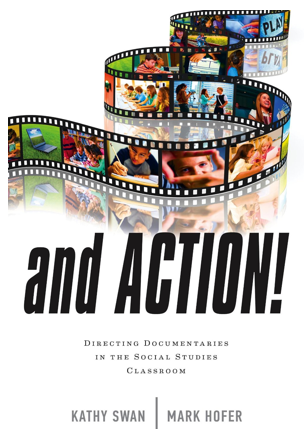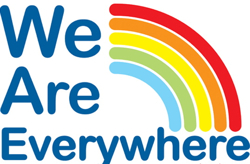This week, the Shifting Our School podcast will tackle the essential question of “How to shift?”. Our previous shows with other EQs delved into discussions that connected this overriding theme to our podcast. So, it is time to combine some thoughts from practical experience.
Brent Loken, the Director of Curriculum and Innovation at Hsinchu International School (HIS), will be our guest for the show. He will offer details about one approach to helping schools make the shift to focusing on the learning of 21st-century skills, constructivist learning instructional strategies, and the variety of interpretations of what School 2.0 can look like. Brent and the leadership team of Grant Ruskovich, Ken Willis, and Catherine Chen took a top-down leadership-driven approach, working with the school board, parents, students, and faculty to define what they wanted their school to be about. This “about” happens to be a significantly shifted school.
As an instructional technologist working under more “normal” conditions with pockets of shifted teachers and often non-committed Leadership towards shifting to School 2.0, I will share some of the practices that I found helpful to move a school I previously worked at to being more shifted. While I list these practices as helpful in guiding a school to Learning 2.0 outcomes, they are accepted strategies familiar to our schools. They can be standard practice in managing organizations.
Administrative Leadership: Despite numerous reasons, administrators can find it challenging to commit to all the change and transition that goes with shifting a school. We must have the administrators at the helm if we are to shift our schools. Our last SOS podcast for the school year in June will look into what barriers administrators face in bringing about change in their schools. As this is a massive topic on its own, I won’t comment further and ask that if anyone is reading this post, tune into our podcast with Brent Loken to hear one leader provide the vision and action steps that administrators can take to shift their schools.
Conversation-Listening-Designing-Action-ASSESSMENT: Deciding where a school community wants to go should start with conversations around the question, “What is learning?”. Additional questions are: What does it look like? What skills will our graduating students have? What will they need to be able to do to be global citizens in an unpredictable world? What is teaching? We can then use the UbD backward process to develop our program plan, action steps, and accountability protocols. This relates to a personal discussion with educators about their teaching philosophy.
Time, along with care and attentive listening, is needed as we grow our learning community and validate one another. Most of us as educators are at some point involved in strategic or other program-building plans. We worked with parents, teachers, administrators, and sometimes students to decide what our mission should be and what outcomes we want our students to attain from our schools. These development processes have documented procedures to find the “how to” steps quickly. I cannot value enough the importance of listening, real attentive listening, which can lead to proper understanding and help move the process along.
Planning comes into play, along with action steps to put all the hard work into action in our classrooms. The part of the process that I find left out for numerous reasons is accountability. This is another huge topic that deserves a great deal of attention. I will say here that if a school is to shift to whatever goals it sets, one needs to take all that energy from the start of the development process to the action and assessment stages. We must answer, “Are we reaching our goals?” and adapt accordingly. Accountability is key.
Defining, Discussing, and Understanding of School/Learning 2.0: This practice ties into the planning process of a school community’s programs. Plenty of charts, posts, and articles contrast what and how we teach with a 20th-century approach to the potential 21st-century version. The Framework for 21st Century Skills website lists the skills, and now, the Route 21 education section provides a terrific place to start the education and understanding effort with one’s school community. The next step is to define what Web 2.0 tools with their strange names do for the learning community without any expectations for learning or using them.
Work to take away the lack of understanding. As an instructional technology program develops around individual and team (i.e., elementary grade level teams, middle school teams & high school departments) needs, you can design a differentiated learning program based on those individual and group adult learning needs in your school’s learning network.
Time: This is usually a top-of-the-list issue at any organization. We often need to build in the time or the procedures to follow through on our plans, making the work that goes with shifting our schools an additional task added to overloaded teachers’ workloads. Time must be structured for the activities that go into the shifting process, taking away other items from teachers’ plates and giving them time during the school day to focus on the shifting. The shifting process needs a great deal of time, as in years, to go from the conversation to the designing to the implementation to the assessment phase.
Focus: I wrote about this in a recent post. We put in a lot of time writing our strategic plans, mission statements, etc., but then stray from them, leaving less time and energy to do what we say we will. My experience with international schools is that they sometimes need to focus on how to use their time after the planning stops. Check out the post, as this also connects to administrative Leadership.
Less is More, Especially with Depth: If we stay focused on what we say we want to do, there will be less on everyone’s plates; thus, we will have a better chance of reaching our goals—common sense. Don’t try to be everything to everyone as a school. Shifted schools live by the mantra, “How does any new program or initiative connect to our strategic plan and mission?” This gets back to administrative Leadership. “No” is not a four-letter word! Our leaders connected to our community learning networks gather lots of information and dialogue and then can make decisions that keep our plates less full and our lives more balanced. We will talk in a future SOS podcast about why such a common sense idea gets dropped by many schools.
Trained Change Agents & Designers: Today, library media specialists and instructional technologists receive particular coursework in designing new programs and implementing them. They also gain skill sets from their graduate programs that support their being able to be 21st-century learners just like we want our students to be. By staying on top of the latest research and continually learning from their PLNs, they have the knowledge and skills to be the on-the-ground leaders who help guide our schools through the change and transition process. Support and empower them to do what they are trained to do.
It might be uncomfortable for some schools to face. Still, old-style technology coordinators, focusing on hardware and networks, have been replaced with today’s instructional/educational technologists who are teachers first, grounded in instructional theory, working to bridge the technology to the teachers and students in the classrooms. We have technicians and network engineers to handle the hardware and repair issues.
With their training and skill sets, the library media specialists guide our teachers and students in the multiple literacies that our 21st-century learners (students, teachers, and administrators) must work with and master to be adaptable and flexible learners. They must be something other than the 20th-century librarian focused on reading literacy and building book collections. They must be leaders and partners in designing and implementing curriculum.
By working as partners with teachers and administrators in the curriculum development process, these two instructional leaders work to support the designing of curriculum to reach the learning goals for our 21st-century-focused schools. To see how the HKIS Upper Primary School teachers and specialists designed their curriculum review process, select the following hyperlink to download a copy of an article reviewing their work. HKIS Upper Primary Curriculum Review Model
Education, Communication, Ownership, and Celebration Procedures: Schools must use their communication channels with the community to share progress, build ownership, and celebrate everyone’s efforts as the school works towards its goals. Once schools start making the move to School 2.0, they need to use ongoing parent workshops, community coffees, student forums, newsletters, blogs, etc. to build out the community learning network with a focus on the shifting process. The school needs to be flexible and adaptable with two-way communication from the community. Along the way, celebrate the successes and shine the light on your risk-takers! So often, those willing to stick their necks out to try new things, offer differing opinions and make the shift are isolated and made to feel devalued. Put these leaders’ efforts on your school Web sites, write about them in newsletters, and get their ideas published in journals. These leaders will “own” the process and share their passion. Ownership means accountability and follow-through. Celebrate your early adopters, and they will stick around instead of looking for more shifted pastures. 🙂
Get the Right Crew Onboard: This is a biggie that can be one of the most significant storms to work your voyage through. Going back to the conversations that start the process, everyone will need to decide if they can commit to the shift once they fully understand it. Administrators will need to work with their Human Resource staff to plan over a few years to give folks the opportunity to seek employment at other schools. As uncomfortable as this can be, we must face that organizations change and that individuals should move on if they cannot support our school’s mission. As in baseball, start scouting early and building a wish list of shifted educators you hope to recruit to your school. Something tells me that this is what Fortune 500 companies do. 🙂
The Curriculum Development Process: Being systematic is central to bringing about change. We must build protocols that support a system that scaffolds our efforts to move toward our goals. Sadly, for so many schools, the curriculum review process can be a struggle and an unsupported effort that gets a bad name. A dynamic, well-managed system becomes a natural professional learning community that can drive how we do business in our schools. See the previous link to the HKIS Upper Primary model for more information.
Work with Your Successes: Students are already learning in our classrooms whether you are School 1.0 or 2.0. We, as teachers, use well-thought-out instructional and assessment strategies. Back to the conversations that start the shifting process, we need to assess what we are already doing well by asking questions like:
Which strategies are working really well? Which ones guide our students to our school-wide learning goals? Which ones can easily be enhanced using 2.0 strategies?
As Rick Pierce points out, we need to remind ourselves that change leads to a much more extended transition period that takes us to our goals. This transition is a continuum that we all move along at different rates of speed and comfort levels. So, create a collaborative team including your instructional technologist, library media specialist, administrators, curriculum coordinator, and other interested parties to design an ongoing adult learning program centered on personal learning networks that start within each individual’s comfort zone and experience. Then, take small steps along the continuum towards using shifted classroom instructional strategies and assessments that support your school’s shifted goals.
A quick example is that concept maps and other graphic organizers are used in classrooms worldwide. Teachers are comfortable using them. Students learn by making connections using HOTS as they map out their learning.
The next step for some might be a desktop digital tool like Inspiration or Cmap, while others might be ready to jump to 2.0 and the collaborative power of Mindmeister or Bubbl with 24/7 access to their work. As time passes, the next step is telecollaborative and blended work, where students and teachers make connections outside the school, still using concept maps but sharing them with learners in projects like The Flat Classroom. Remember to start with your current successes and honor the innovative work already getting results as you design each teacher’s shifting experience.
Another obvious point is to make your professional development program connect to your shifting school outcomes in an ongoing, structured learning community that periodically gives learning and connection time during the school day while avoiding the end of quarter one shot; one size fits PD days. Adult learners deserve and need differentiated to personalized instruction along with time to make meaning from their experiences and the opportunity to apply their new learning to give them half a chance for success. And look to work with the professionals within your school who have attended conferences, read leading educational books, and are on top of the edublogosphere to provide ongoing coaching who will be with you every day instead of a consultant’s couple-day visit.
You might go the extra step, adding the depth of an experienced consultant to partner with your teachers by having them stay for weeks or months. Both Hong Kong International School and Hsinchu International School are using this model.
Stick To Your Guns: Much of what I write here is accepted and practical knowledge. If a school community does all of these listed strategies and more, they can feel confident that they are inclusive, transparent, systematic, and focused in their shift. There will still be difficulties and uncomfortable feelings, but LEARNING is all about that. Taking risks is so important!
Everyone from the administrator at the helm to the crew and passengers working together to stay the course while showing the courage to stand by their planning and initial goals is central to the shifting process. This courage sometimes fails, especially when the dreaded “Well, the parents say …” and we as educators forget we are the professionals hired to teach the students and run the school. 🙁
Final Note: As stated at the start, my experience is from working at a non-shifted school without a school-wide initiative or committed Leadership to make the shift. We dug in and did our best as a group of educators working within the system. Brent Loken and Grant Ruskovich took a different tack with their work at HIS. Download the SOS podcast later in the week to hear about their efforts.






